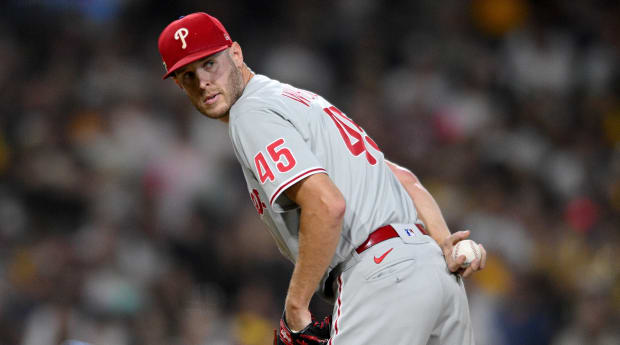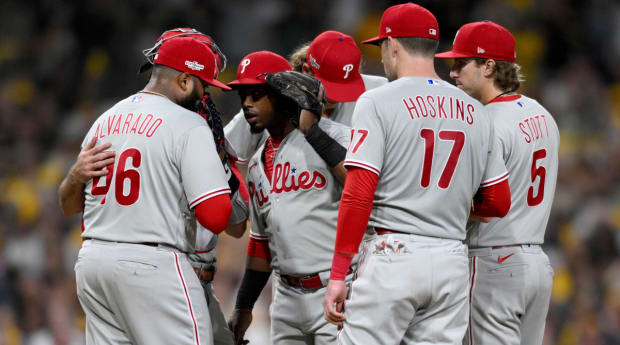SAN DIEGO — Here it is. Try to hit it.
Has baseball ever been distilled to anything more basic than that? Such bravado is disappearing in the game. Spin is in. Deception dominates. For the first time in recorded history, major league pitchers threw fastballs with less than half their pitches, 48.6%. Just six years ago it was 56.3%. More than 68,000 fastballs went poof! in the name of advanced metrics, pitching labs and incredibly detailed scouting reports on hitters.
The Phillies don’t play that postmodern, passive-aggressive game. They are dialing up the heat and turning back the clock. The Padres learned that very hard lesson Tuesday night in Game 1 of the National League Championship Series.
Philadelphia held San Diego to one hit, a single, while throwing 62% fastballs. That started with seven innings from Zack Wheeler, who averaged 97.2 mph on his heater, which made him the softest tosser of the night for the Phillies. Seranthony Dominguez (99.6) and Jose Alvarado (99.8) took care of the final six outs by turning up the heat on the grill even more.
“Listen, that’s our identity,” pitching coach Caleb Cotham says. “We do it differently than what’s in vogue. Especially this time of year, we’re not as concerned as some others about pitching to hitters’ weaknesses. We go strength on strength.”

Orlando Ramirez/USA TODAY Sports
To beat the Padres, you must control Juan Soto and Manny Machado. Wheeler pitched Soto carefully. But what Philadelphia did with Machado tells you all you need to know about its preferred path to the World Series: Here it is. Try to hit it.
The Phillies threw Machado 19 pitches; 16 of them were fastballs clocked between 95 and 100 miles per hour. And when we’re talking fastballs, we’re not talking about those fancy cut fastballs, which are modified sliders. We’re talking country hardball heaters: four-seamers and sinkers.
Machado saw one pitch below 93 mph all night. He went 0-for-4 against that barrage of fastballs. It was only the second time all year Machado went 0-for-4 in which every out resulted from a fastball.
“Tonight, it worked out,” Cotham said. “But that’s our strength. That’s our identity.”
The Padres went 0-for-6 on first pitches, five of them on heaters in the strike zone. Translation: even when San Diego hitters sat on first-pitch fastballs in the zone, they did not do damage with them.
“They have good hitters and you don’t want to pitch behind in the count,” Cotham says. “So we’re going to take our chances 0-0 rather than get behind. And the way to do that is attack the zone. If we have to adjust, we adjust. But that’s our strength and we will stick with it until we have to adjust.”
The Phillies are the swaggiest team still standing. They play with their chest out and chin up and take on teams with the confidence of a bare-knuckled brawler. This is what happens when you are loaded with power pitchers, your offense is built on crushing home runs and you spend 20 of the past 23 days on the road fighting for your playoff lives.
“No doubt we’ve come together as a group even more,” says Bryce Harper, who drilled his fourth homer of the postseason, a modest blow compared to the 488-foot rocket off the bat of Kyle Schwarber. “Belief. We believe in ourselves.”
The Phillies ended the regular season with a 10-game trip to barely qualify as the sixth and final seed, took two straight games in St. Louis in the wild card series, won one of two in Atlanta, came home and closed that LDS with two wins, and have opened this NLCS with another road win, with Aaron Nola (zero earned runs in two postseason starts) getting the ball Wednesday in Game 2. They are 6–1 this postseason, including 4–1 on the road.
“The guy going [in Game 2],” Cotham says about Nola, “may not have the velo Wheels does, but he has impeccable, off-the-charts command of his fastball.”
During the regular season, the Phillies threw 52% fastballs, the third most in baseball, and the highest rate of any playoff team. Among starters with at least 2,300 pitches, Wheeler ranked ninth in fastball rate (59.4%), Ranger Suarez ranked 11th (57.9%) and Nola ranked 23rd (52.2%)—all well above major league average.
Wheeler is throwing harder than he has all year and has allowed only four runs in his last six starts since the Phillies—against his stubborn wishes—gave his arm a rest by putting him on the IL.
“It was a bit of a gamble when you consider how we got in,” Cotham says, “but the way Bailey Falter was throwing, we thought we could afford it because we wanted to have Wheels at his best when we needed him the most.”
Dominguez, whose velo was up 2 mph in Game 1, and Alvarado, up 0.2 mph, also are throwing better than they have all year.
“Yes,” Cotham says when asked if all three are pitching at their peak in October, “and that’s a credit to our training and conditioning staff that tweaked a lot of programs just a bit, especially with recovery, as well as the buy-in we got from all the players. Everything we put in during the year is paying off.”
Of course, it would not be a true Phillies game without one spot of banana-peel defense. What might have been a game-ending double play became a tense moment when third baseman Alex Bohm misfired on a throw to second base in the ninth. That brought up Machado as the go-ahead run.
Catcher J.T. Realmuto gathered the infielders around Alvarado on the mound. How would they get out of this?
“Trust a hundred [mph],” first baseman Rhys Hoskins said. “It’s pretty easy to do that. It was nice to all gather together, too.”

Orlando Ramirez/USA TODAY Sports
Alvarado fell behind Machado with a 94-mph cutter. The fans at Petco Park were in all their screaming, towel-waving glory, expecting a sequel to the five-run rally in the NLDS that slayed the Dodgers. Alvarado would quiet them quickly.
Sinker at 99 for a called strike.
Sinker at 100 for a flyball and the second out.
Alvarado then jumped ahead of Josh Bell on a 101-mph sinker before finishing him off with a 93-mph cutter. The Phillies threw 23 of their 109 pitches at 99 and harder.
“We got a hundred from the left side after a hundred from the right side,” Hoskins said.
The tenor of the series has been set. The Phillies took control of it with a show of force on the mound and at the plate. They have Wheeler and Nola lined up to pitch four of the first six games on full rest, which could draw comparisons to Randy Johnson and Curt Schilling for Arizona in the 2001 postseason.
To stop them, the Padres will need their own stable of stars to show up: Blake Snell on the mound in Game 2 and Soto and Machado in the batter’s box. They had better hurry, because seven games into the postseason, the Phillies are getting bolder with every sizzling fastball they throw, and every mammoth home run they hit.







